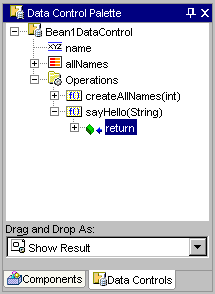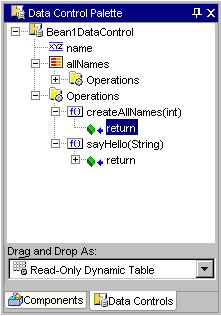Create the ADF-enabled web page or ADF-enabled Swing panel and open it in the Visual Editor.
Choose View | Data Control Palette to open the palette.
Expand the Data Control Palette hierarchy.
The Data Control Palette displays two types of method returns inside the Operations folder of the data control:
-
Methods that return a collection or structured object are
identified by the
 icon.
icon.
You may need to define the type of the collection being returned.
-
Methods that return a scalar value are represented by the
 icon.
icon.
If you want to display the result of an method that returns a scalar, your application must provide the means to execute the method in order to create the ADF action binding before the result can be displayed. See Supplying Method Parameters for an ADF Method Invocation.
To display the result of a method invocation, expand the Operations folder at the root level, locate the method return node, and select the desired visual element from the dropdown list.
Note, Show Result will appear in the dropdown list, when the method invocation returns a scalar value:

Note, Read-Only Dynamic Table will appear in the dropdown list when the method invocation returns of a collection with no attributes defined:

Add the dynamic display component into your web page by dragging the selection from the top portion of the Data Control Palette into the open web page in the Visual Editor.
If the method that your action executes takes parameters, supply the parameter values.
An iterator binding definition is created in the binding definitions file for the displayed web page.